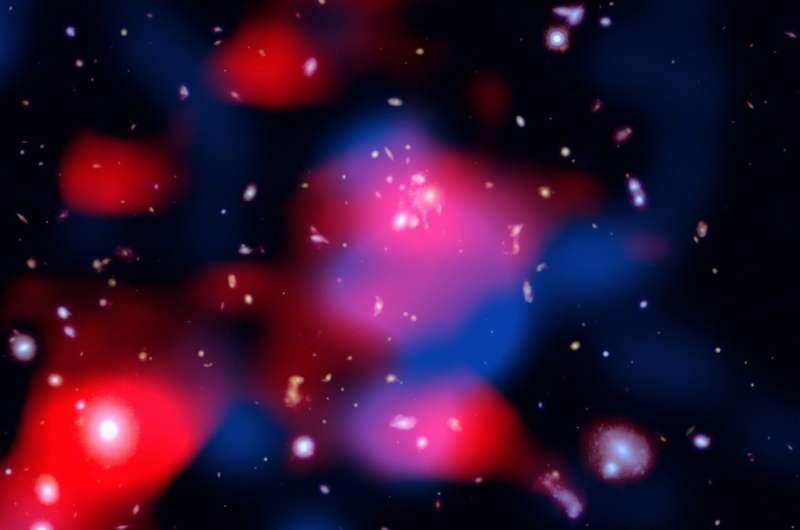Discovery of 'Mini Halo' Offers Insights into Early Universe Formation

June 26, 2025
by University of Montreal
edited by Sadie Harley, reviewed by Andrew Zinin
scientific editor
lead editor
This article has been reviewed according to Science X's editorial process and policies. Editors have highlighted the following attributes while ensuring the content's credibility:
fact-checked
peer-reviewed publication
trusted source
proofread
Astronomers have uncovered a vast cloud of energetic particles—a 'mini halo'—surrounding one of the most distant galaxy clusters ever observed, marking a major step forward in understanding the hidden forces that shape the cosmos.
The mini-halo is at a distance so great that it takes light 10 billion years to reach Earth, making it the most distant ever found, doubling the previous distance known to science.
The discovery demonstrates that entire galaxy clusters, among the largest structures in the universe, have been immersed in high-energy particles for most of their existence.
Such a mini-halo consists of highly energetic, charged particles in the vacuum between galaxies in a cluster, which together emanate radio waves that can be detected from Earth.
Published in The Astrophysical Journal Letters, the findings show that even in the early universe, galaxy clusters were already shaped by energetic processes.
The international team of researchers behind the discovery was co-led by Julie Hlavacek-Larrondo of Université de Montréal and Roland Timmerman of the Institute for Computational Cosmology of Durham University, in the U.K.
The researchers analyzed data from the Low Frequency Array (LOFAR) radio telescope, a vast network of over 100,000 small antennas spanning eight European countries.
While studying a galaxy cluster named SpARCS1049, the researchers detected a faint, widespread radio signal. They found that it did not emanate from individual galaxies, but from a vast region of space filled with high-energy particles and magnetic fields.
Stretching over a million light-years, this diffuse glow is a telltale sign of a mini-halo, a structure astronomers have only been able to observe in the nearby universe up until now.
'It's as if we've discovered a vast cosmic ocean, where entire galaxy clusters are constantly immersed in high-energy particles,' said Hlavacek-Larrondo.
Timmerman added, 'It's astonishing to find such a strong radio signal at this distance. It means these energetic particles and the processes creating them have been shaping galaxy clusters for nearly the entire history of the universe.'
There are two likely explanations behind the formation of the mini-halo.
One is that there are supermassive black holes at the hearts of galaxies within a cluster that can eject streams of high-energy particles into space. However, astronomers are still trying to understand how these particles would be able to migrate away from the black hole to create such a gigantic cloud of particles, while maintaining so much of their energy.
The second explanation is cosmic particle collisions. This is when charged particles within the hot plasma of the galaxy cluster collide at near-light speeds, smashing apart into the highly energetic particles that can be observed from Earth.
This new discovery provides a rare look at what galaxy clusters were like just after they formed, the astronomers say.
It not only shows that galaxy clusters have been infused with these high-energy particles for billions of years more than previously known, but it also allows astronomers to study where these high-energy particles come from.
It suggests that black holes and/or high-energy particle collisions have been enriching the environment of galaxy clusters much earlier than expected, keeping them energized over billions of years.
With newer telescopes being developed, such as the Square Kilometer Array (SKA), scientists will be able to detect even fainter signals and further explore the role of magnetic fields, cosmic rays, and energetic processes in shaping the universe, the astronomers say.
'We are just scratching the surface of how energetic the early universe really was,' said Hlavacek-Larrondo. 'This discovery gives us a new window into how galaxy clusters grow and evolve, driven by both black holes and high-energy particle physics'
More information: A Radio Mini-Halo in a Massive Cool Core Cluster of Galaxies at z = 1.709, The Astrophysical Journal Letters (2025). On Arxiv: doi.org/10.48550/arXiv.2506.19901
Journal information: Astrophysical Journal Letters, arXiv
Provided by University of Montreal




